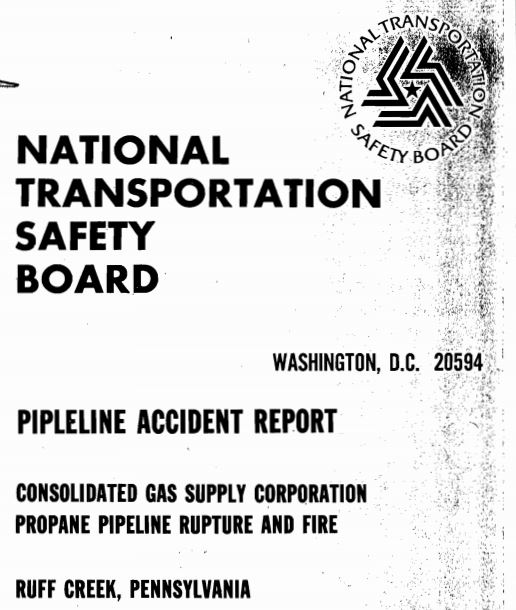
This post looks at the dark side of the risk we face with the Dragonpipe (Mariner East 2 pipeline) and asks: Is this risk acceptable?
Here are two versions of the same story. One is true, and the other is hypothetical. I would like you to read them both and consider whether the second describes a risk we are willing to take in routing a dangerous pipeline through an area of dense population.
Version one. The following text is copied directly from the Abstract section of a report by the NTSB of a pipeline incident.
At 4:30 a.m. EDT on July 20, 1977, a 12-inch propane pipeline, owned by the Consolidated Gas Supply Corporation, ruptured near the town of Ruff Creek, Pennsylvania. The liquid, under 450-psig pressure, escaped from the pipeline, vaporized, and propane gas fumes settled like a fog over the bottom of a valley. About 6 a.m., two men in a pickup truck entered the propone cloud; the truck stalled and the propane gas ignited when an attempt was made to restart the truck. A flash fire, approximately 100 yards wide, followed a streambed located along the bottom of the valley and burned everything in its path for a distance of 1 mile.
As a result of this accident, the 2 persons in the truck were killed, the truck was destroyed, 57 head of cattle were killed, overhead power and telephone lines were destroyed, a hay storage shed containing 450 bales of hay was burned, 1,800 barrels of propane burned, and a meadow and wooded area 1 mile long by 100 yards wide was burned.
The National Transportation Safety Board determines that the probable cause of the accident was the failure by stress-corrosion cracking of a 12-inch propane pipeline which had been subjected to earth subsidence caused by previous coal mining operations underneath the pipeline.
Version two. Now, thanks to the magic of find-and-replace, here is an alternative version of that story:
At 4:30 a.m. EDT on July 20, 2022, a 20-inch NGL pipeline, owned by Sunoco/Energy Transfer Partners, ruptured in the town of Exton, Pennsylvania. The liquid, under 1,100 psi pressure, escaped from the pipeline, vaporized, and NGL gas fumes settled like a fog over the bottom of a valley. About 6 a.m., two men in a pickup truck entered the NGL cloud; the truck stalled and the NGL gas ignited when an attempt was made to restart the truck. A flash fire, approximately 100 yards wide, followed a streambed located along the bottom of the valley and burned everything in its path for a distance of 1 mile.
As a result of this accident, the 2 persons in the truck were killed, the truck was destroyed, 20 people in nearby homes and 30 people in nearby vehicles were killed, overhead power and telephone lines were destroyed, the county library was destroyed, 1,800 barrels of NGL burned, and numerous homes, commercial buildings and trees in an area 1 mile long by 100 yards wide were burned.
The Pipeline Hazardous Materials Safety Administration determines that the probable cause of the accident was the failure by stress cracking of a 20-inch NGL pipeline which had been subjected to earth subsidence caused by a sinkhole that formed underneath the pipeline.
Can anyone tell me why the second version of the story is never going to happen? No, they can’t. There have been modest improvements in pipeline construction and monitoring in the intervening years, but the fundamental problem is the same: if you bend a pipe enough, it will rupture. And the volumes, pressures, materials, and location involved in the second story all mean that the outcome would be far, far worse.
I find the risk represented by the second story to be unacceptable. That is why I feel we need to stop the construction of the Dragonpipe, to prevent the second story from ever taking place.

Yes!
=== Bernie Banet === Ann Arbor, Michigan
On Wed, Mar 14, 2018 at 7:51 AM, Dragonpipe Diary wrote:
> galex49 posted: ” This post looks at the dark side of the risk we face > with the Dragonpipe (Mariner East 2 pipeline) and asks: Is this risk > acceptable? Here are two versions of the same story. One is true, and the > other is hypothetical. I would like you to read them bot” >
LikeLike